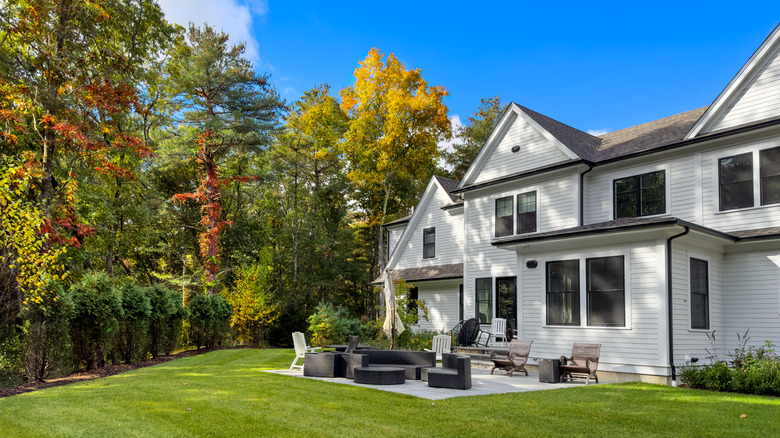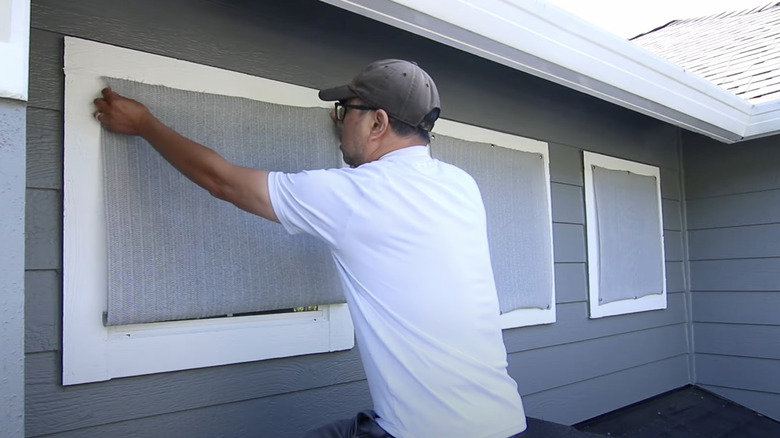The Efficient DIY That Can Lower Energy Costs And Give Outdoor Windows A Refresh
We may receive a commission on purchases made from links.
The weather's heating up, and you know what that means: your AC bills are too. And with the creeping cost of utilities, it can feel like an ongoing battle between keeping your home cool and trying to keep the utility bills down. If you're looking for ways to help reduce your energy costs at home, start with your windows — or, more specifically, outside your windows with DIY solar screens.
Windows not only let in the sunshine and fresh air, but also the heat. Which is lovely in the cold of winter, but in the height of summer? Not so much. To cut down on up to 90% of heat streaming through your windows and heating your home in the summer, DIY solar sunscreens to attach over your windows that get the most light (or all of them). These window coverings can cut the heat back up to 30 degrees, meaning your AC doesn't have to work as hard to keep your home at a comfortable temperature. (It's also a creative way to cool your home without air conditioning.) Plus, they'll add a clean, uniform look to your windows, boosting your curb appeal. Let's walk through everything you need to know to DIY your own.
What kind of solar sunscreen fabric should you get?
Typing "solar sunscreen fabric for windows" into Google returns an overwhelming amount of results. How are you supposed to find the right one? PVC-polyester covered fabrics are some of the best options because they are durable enough to withstand the outdoor elements. Next, look for how much sun the fabric blocks. This is typically shown as a percentage from 45% to 90%. 80% and 90% is recommended to cut down on the heat and glare while still allowing airflow and visibility outside.
Next, think about visibility. The best gauge for this is checking the openness factor — aka how big the gaps are in the fabric's weave. If you want to be able to easily see outside, look for a higher openness factor. You can still see through fabric with a lower openness factor — it'll just be a tad more opaque.
Now, when it comes to the color of your solar sunscreen, experts are divided. Some say it doesn't matter what color the shade is. Others say darker shades are the best at keeping the heat out as well as allowing you to see outside, and that lighter ones will allow the sunlight to create a soft, filtering light instead of a harsh glare. Our recommendation is to try a couple different samples for yourself on the windows that get hit hardest by the sun.
How to build DIY solar sunscreens
DIYing solar sunscreens is one of our favorite tips to keep your home protected in extreme heat. However, depending on your windows, it may take a few weekends to get it done.
First, measure your windows' length and width. Then cut your boards to size and use screws to create a window frame. Exterior plywood is a popular option for this because it's inexpensive, easy to find, and suitable for the outdoors. Paint the frame to match your home's trim for a neat look. Once dry, lay out the solar sunscreen fabric like NeatiEase Store Solar Window Screen Mesh, and use a staple gun to attach it on all four sides. Then attach the screen to the outside of your windows. There's a few different options to do so; if you want to keep the screens up long term, screws are a good option. If you'd like to be able to take them down at the end of summer, you can hang them in place with hooks, or use 3M Dual Lock, attaching one side to the screen frame, the other to the exterior of your home, and snap it into place.

